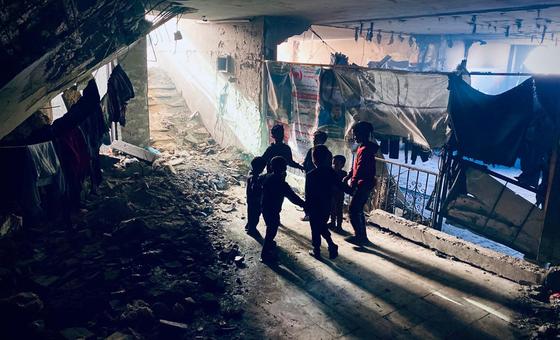The past two weeks have seen a variant of poliovirus type 2 detected in sewage samples in Gaza, deadly military strikes in several neighbouring countries, and the confirmation of famine in Sudan’s North Darfur state, among other challenges.
Rebuild health systems
WHO Regional Director Dr. Hanan Balkhy voiced grave concern over the ongoing escalation across the region, characterized by “deadly strikes against civilians, political entities, and infrastructure” which “are rapidly raising the risks of a wider war.”
She said civilian populations already ravaged by violence, hunger and disease, do not deserve to be further threatened.
“Health systems must be rebuilt, not devastated, and further developed so that they can withstand further shocks that could potentially affect us all, like the next pandemic,” she said.
In the face of the escalating political tensions, she stressed that “all diplomatic efforts must be made to prevent this worrying situation from spiraling further.”
Polio campaigns for Gaza
Meanwhile, polio in Gaza is of great concern. Dr. Balkhy warned that although no cases have been detected, children are at high risk.
In response, WHO is working with the Ministry of Health in Gaza and the UN Children’s Fund (UNICEF) on a range of measures, including polio vaccination campaigns which will begin very soon.
“Let me be clear – we need a ceasefire, even a temporary ceasefire – to successfully undertake these campaigns. Otherwise, we risk the virus spreading further, including across borders,” she said.
Vaccines on the way
Dr. Hamid Jamari, Polio Eradication Director at the WHO Regional Office, said some 500,000 children under eight, will be targeted in two rounds of vaccination campaigns.
He said the WHO Director-General, Tedros Adhanom Ghebreyesus, has already authorized the release of sufficient doses of the novel oral polio vaccine type two from global stocks, which are held in Indonesia.
“Of course, the challenge is when can we get these vaccines through to Gaza,” he said, citing issues such as the current tensions in the region, logistical difficulties and flight cancellations.
“And once the vaccines get there, then we need a massive change in the current environment which is not only ceasefire and peace so that children can be vaccinated, but we also require freedom of movement.”
Planning for a ‘massive operation’
Dr. Rik Peeperkorn, WHO Representative in the occupied Palestinian territory, added that “everything has to be aligned, including the cold chain and cold chain equipment”, referring to the correct conditions for storing, transporting and distributing vaccines.
Speaking from Jerusalem, he said that WHO and partners have already started “microplanning” for the vaccination campaigns, describing them as a “massive operation”. This will be followed by the training of health workers and volunteers, and the roll-out of risk communications.
“To carry out these kinds of campaigns, you prefer to have a ceasefire,” he said. “If that’s not possible, then at least there should be what we call ‘days of tranquility’”.
Like his counterpart, Dr. Peeperkorn also underlined the importance of freedom of movement.
He explained that the comprehensive vaccination campaigns would have to be carried out “from fixed points, from mobile teams, and, when feasible…as much as possible from door-to-door. Or, in Gaza, it would be from tent-to-tent.”
Thousands awaiting medical evacuation
Regarding other Gaza developments. Dr. Balkhy reported that WHO supported the largest medical evacuation from the enclave so far in the war, with 85 seriously ill people and their companions taken to the United Arab Emirates (UAE) at the end July.
This “extremely complex operation” involved transporting the group through the Kerem Shalom crossing, and then onto an Israeli airport, before flying to the UAE.
She explained that the easier route would have been through the Rafah crossing with Egypt, which has been closed since 6 May.
In total, “nearly over 100 Gazan patients” have been evacuated with WHO support, including to Belgium and Spain. However, some 10,000 people there still require medical evacuation.
Emergency contingency plans
In the face of regional escalation, WHO is deploying emergency experts and vital supplies to support the Ministry of Health in Lebanon, in addition to providing equipment, technical assistance and staffing for its Emergency Operations Centre.
The agency has also bolstered the capacity of 98 hospitals for mass casualty management and the prepositioning of 20 trauma kits and other lifesaving supplies.
“As we work with health officials in Syria, Iran, Jordan and other countries on emergency contingency plans, we hope and pray that they never need to be activated,” she remarked.
Access across Sudan
Dr. Balkhy also addressed the situation in Sudan, where war has pushed parts of North Darfur state into famine, notably the Zamzam displacement camp, home to least 500,000 people. Other areas are potentially at risk.
“These entirely avoidable developments raise the stakes for our humanitarian operations. We urgently need access to those in need by all routes possible, including cross-border,” she said.
Climate change threat
Turning to other locations in the region, she noted that extreme weather events including floods, deadly heatwaves and storms have disrupted lives and livelihoods.
She said WHO “acted quickly” following recent severe flooding in Afghanistan that killed 58 people and injured 380, which included dispatching 160 metric tonnes of medical supplies, deploying 24 ambulances for referrals, and activating mass casualty management systems.
The floods and heatwaves are occurring in the context of severe climate, and she highlighted the wider impacts on health.
“Climate change is a fundamental threat to people’s health and the time for collective, concrete actions is now,” she said. “We need to understand that this threat knows no borders and leaves no one safe.”

